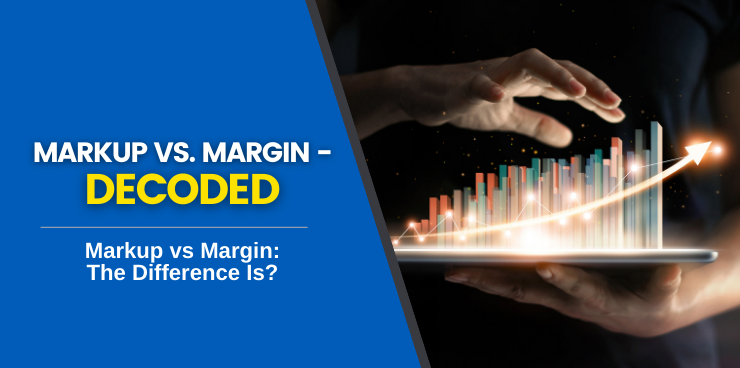When you hear the terms “profit markup” and “profit margin,” you may assume that they are one and the same.
However, there is a big difference between the two, and if you’re looking to maximize your business’s profitability, it’s important that you understand the distinction.
To understand markup vs. margin, you first need to know that they differ in terms of what costs they include.
Both show the relationship between selling price and cost, but markup includes only the variable costs of goods sold (COGS), while margin includes both variable and fixed costs.
We’ll be expanding on this, and many other key concepts of markup vs. margin below. So keep reading if you want to leverage this pricing strategy to improve your business’s bottom line!
Profit Markup Definition
Profit markup is the difference between the selling price of a good or service and the cost of providing it. The term “markup” comes from the fact that businesses typically add an amount (markup) to their costs to generate a profit.
There are a few ways to calculate profit markup, but the most common is simply to take the selling price and divide it by the cost. This will give you the markup percentage. The formula goes as follows:
Margin ÷ COGS (Cost of Goods Sold) = Profit Markup Percentage
For example, if a product costs $10 to produce and is sold for $20, then the markup percentage would be 100 percent.
Profit Margin Definition
Gross profit margin is the direct profit a company makes after deducting the COGS. This is useful for businesses to understand how much profit they are making from their sales. To calculate margin, businesses take their total revenue and subtract their cost of goods sold (COGS).
The dollar gross margin formula:
Net Sales Revenue – COGS (Cost of Goods Sold) = Gross Profit Margin
Your gross profit percentage tells you what percentage of your total sales is gross profit. It can be used to help you monitor your financial health and make decisions about pricing and expenses.
The percentage formula:
(Revenue – Cost of Goods Sold) / Revenue x 100 = Gross Profit Margin
If your gross profit margin is low, it may mean that you need to reduce your costs or increase your prices. If your gross profit margin is high, it may mean that you have pricing power or room to invest in growth.
At Wizard of Sales®, we help you reengineer your mindset around markup vs. margin, shifting the focus to the actions and behaviors necessary to generate the revenue profitably while protecting the long-term relationship goals you have for your clients.
Book a demo with us today to get started!
Markup vs. Margin
Profit Margin refers to the percentage of profit that a company makes on each sale, after taking into account all variable costs associated with selling and delivering the product or service and any discounts given to sell the solution.
These costs can include:
- The cost of equipment and materials, including shipping and handling.
- The cost of labor to install the product, including subcontractors.
- The cost of services and permits.
- The cost of commissions.
- The cost of financing.
Profit Markup, on the other hand, refers to the percentage of profit that a company adds on top of the COGS in order to generate revenue. In other words, markup is the difference between COGS and selling price.
It’s important to note that markup and margin are two different things. Markup is a company’s pricing strategy, while margin is the percentage of profit the company makes on each sale.
The biggest factor that can negatively affect profit margin are the costs of selling the goods that are related to the retail price it sells at, including the cost of financing, commissions, and discounts offered. These same factors don’t affect the mark up, therefore, it is important you take this into consideration when building your pricing strategy.
When You Should Use Markup vs. Margin?
So, what’s the best way to price products and services? It depends on several factors, including your business model, your competition, and your costs. Here’s a closer look at when you should use markup vs. margin.
When to Use Margin
Margin is best suited for businesses with low fixed costs and high variable costs. For example, residential home service businesses have high variable costs (e.g., they pay for equipment as needed, commissions, and substantial financing fees).
When to Use Markup
Markup is best suited for businesses with high fixed costs and low variable costs. For example, businesses that manufacture products or provide services typically have high fixed costs (e.g., they need to carry inventory) and low variable costs (e.g., they don’t pay for customer acquisition).
Both margin and markup are important pricing strategies, but it’s important to know when to use each one. Generally, businesses with high fixed costs and low variable costs should use a margin pricing strategy, while businesses with low fixed costs and high variable costs should use a markup pricing strategy.
 Examples of Margin and Markup
Examples of Margin and Markup
To paint a better picture, let’s provide you with a couple of examples of markup vs. margin in real-life scenarios.
Say you are an HVAC company. You just landed a new client who needs their home’s heating and cooling system repaired. Your Technician goes to the home, diagnoses the problem, and provides a quote for the repair.
To calculate the gross profit margin, we take the selling price of the repair and subtract the cost to do the repair. The selling price of the repair is $1,000 and it costs your company $500 to perform, so you start calculating your gross profit margin…
(Revenue – Cost of Goods Sold) / Revenue x 100 = Gross Profit Margin
$1,000 – $500 = $500
$500/$1,000 x 100 = 50%
In this case, the gross profit margin is 50%. That means for every dollar your company makes in revenue, 50 cents is profit that will contribute to your fixed expenses and net profit.
Now let’s say you’re in the home remodeling business and you’re customer has asked for a quote to install a new roof. You want to make a profit of $1,000 on this job and your cost of goods is $2,500. To see how much you should price the job, you need to calculate the profit markup…
Margin ÷ COGS (Cost of Goods Sold) = Profit Markup Percentage
$1,000 ÷ $2,500 = 40%
In this case, you would price the job at 40% above your cost of goods, or $3,500.
As you can see from these examples, markup and margin are two different ways of calculating how much profit you’ll make on a job. They both start with the same information — your costs and your selling price — but they use that information in different ways to get to the final profit number.
Now that you know your margin and markup, you can price your product or services accordingly. Remember, price too high and you might lose the sale, price too low and you might not make a profit.
 Key Takeaways
Key Takeaways
So, what’s the final verdict on markup vs. margin?
The markup and margin methods are both ways of pricing products and services. Each has its own pros and cons, so it’s important to understand both before deciding which one is right for your business. Here’s a quick overview of each pricing method:
Margin
The price margin is the difference between the cost of the good or service and the selling price. The margin cost is the amount that the company needs to make to cover its costs and make a profit.
Advantages:
- Easier to calculate than markup.
- You can quickly see how much profit you’re making on each sale.
- Helps you price products based on the cost of the good or service.
Disadvantages:
- You have a double calculation to get your real profit margin if you have commissions, financing, and discounts off of the retail price to factor in.
Markup
Markup is the percentage of the cost of the good or service that you add to the price. For example, if you have a product that costs $10 and you want to price it at $15, your markup would be 50%.
Advantages:
- You can price products based on what the competition is charging.
- Helps you price products based on what the customer is willing to pay.
Disadvantages:
- You may not be making as much profit as you could with price margin.
- Your prices may be lower than your competition’s.
No matter which one you choose to use, price margin or markup, the important thing is to be consistent throughout your pricing process.
Some businesses choose to use price margin because it gives them more control over their profits. By adding a percentage to the cost of the product, they can ensure that they are making the profit they want to make. Other businesses choose to use markup because it is easier to calculate or because they feel it provides more flexibility.
And if you need more help with your markup vs. margin pricing, Wizard of Sales® can guide you through it step-by-step!
Our CORE Playbook applies, documents, and codifies everything you’ve learned in your best practices groups, sales training, and school of hard knocks.
But this isn’t just shelf help. Your CORE Playbook is a built-in Trainual, and serves as your complete onboarding, training, and ongoing development learning center for your employees, all without YOU having to lift a finger.
We codify your performance metrics into the CORE Playbook to ensure your managers and employees are crystal clear on how to achieve success daily.
It’s simple, actionable, and it works.
Book a demo with us to start your business revolution today!



 Examples of Margin and Markup
Examples of Margin and Markup Key Takeaways
Key Takeaways